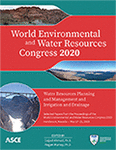World Environmental and Water Resources Congress 2020
An Artificial Intelligence Model to Predict Crop Water Requirement Using Weather, Soil Moisture, and Plant Health Monitoring Data
Publication: World Environmental and Water Resources Congress 2020: Water Resources Planning and Management and Irrigation and Drainage
ABSTRACT
Although the use of new tools and technology for irrigation is becoming more popular, the use of methodology such as evapotranspiration to determine the irrigation amount is relatively old and may result in over or under irrigation. Since crop water requirement is function of many parameters, a thorough study is thus required to determine more important parameters that contribute to estimating crop water requirement. These important parameters then can be used to develop an artificial intelligence model, which is expected to be predicting the crop water requirement with minimum errors. The methodology to predict the crop water requirement presented in this paper consists of the following steps: (a) collecting field and weather data, (b) classifying soil moisture data to estimate crop water requirement, (c) identifying important input variables for the crop water requirement by correlation analysis, and (d) developing artificial intelligence models to predict crop water requirement using the important parameters identified in the previous step. The methodology has been applied to analyze olive field data at the University Agricultural Laboratory (UAL) at California State University Fresno. Results show that past PSM (positive change in soil moisture) data can be used to predict future crop water requirement. Besides PSM, soil temperature (ST) and cumulative evapotranspiration (CET) show higher correlation when they are used as a single input variable for the neural network model at lags 3 days and 11 days respectively. When two input variables are used to train the network, the combination of ST and PSM; and SR (solar radiation) and ST at lags 3 days and 6 days show better performance.
Get full access to this article
View all available purchase options and get full access to this chapter.
ACKNOWLEDGMENTS
Partial funding for this project has been provided by the California State University (CSU) Agricultural Research Institute (ARI) and the Irrigation Innovation Consortium (IIC) 2019 Research Program as part of the primary award from the Foundation for Food and Agriculture Research (FFAR).
REFERENCES
Antonopoulos, V. Z., and Antonopoulos, A. V. (2017). "Daily reference evapotranspiration estimates by artificial neural networks technique and empirical equations using limited input climate variables." Computers and Electronics in Agriculture, 132, 86-96.
Brusberg, M. D., and Shively, R. (2015). “Building drought resilience in agriculture: Partnerships and public outreach.” Weather and Climate Extremes, 10, 40–49.
Burt, C., Howes, D., and Wilson, G. (2003). California Agricultural Water Electrical Energy Requirements – Final report, California Agricultural Water Electrical Energy Requirements, ITRC Report No. R 03-006.
CDFA. (2015). California Agricultural Statistics Review, 2014-2015. California Agricultural Statistics Review, 2014-2015, rep.
DeOreo, W. B., Mayer, P. W., Martien, L., Hayden, M., Funk, A., Kramer-Duffield, M., Davis, R., Henderson, J., Raucher, B., Gleick, P., and Heberger, M. (2011). California Single Family Water Use Efficiency Study – Final Report, sponsored by California Department of Water Resources and managed by Irvine Ranch Water District, June 1, 2011.
Feng, Y., Peng, Y., Cui, N., Gong, D., and Zhang, K. (2017). "Modeling reference evapotranspiration using extreme learning machine and generalized regression neural network only with temperature data." Computers and Electronics in Agriculture, 136, 71-78.
McCready, M.S., Dukes, M.D., and Miller, G.L. (2009). “Water Conservation Potential of Smart Irrigation on St. Augustinegrass.” Agricultural Water Management, 96, 1623-1632.
Mehdizadeh, S. (2018). "Estimation of daily reference evapotranspiration (ETo) using artificial intelligence methods: Offering a new approach for lagged ETo data-based modeling." Journal of hydrology, 559, 794-812.
Nikam, S. S., Mishra, A., Sarangi, A., Shirsath, P. B., Singh, D., and Ramasubramanian, V. (2010). "Artificial neural network models to predict wheat crop evapotranspiration." J. Agr. Eng, 47(2), 20-25.
Perea, R. G., Poyato, E. C., Montesinos, P., and Díaz, J. A. R. (2019). "Optimisation of water demand forecasting by artificial intelligence with short data sets." Biosystems engineering, 177, 59-66.
Tang, D., Feng, Y., Gong, D., Hao, W., and Cui, N. (2018). "Evaluation of artificial intelligence models for actual crop evapotranspiration modeling in mulched and non-mulched maize croplands." Computers and electronics in agriculture, 152, 375-384.
Information & Authors
Information
Published In
World Environmental and Water Resources Congress 2020: Water Resources Planning and Management and Irrigation and Drainage
Pages: 9 - 14
Editors: Sajjad Ahmad, Ph.D., and Regan Murray, Ph.D.
ISBN (Online): 978-0-7844-8295-7
Copyright
© 2020 American Society of Civil Engineers.
History
Published online: May 14, 2020
Published in print: May 14, 2020
Authors
Metrics & Citations
Metrics
Citations
Download citation
If you have the appropriate software installed, you can download article citation data to the citation manager of your choice. Simply select your manager software from the list below and click Download.
